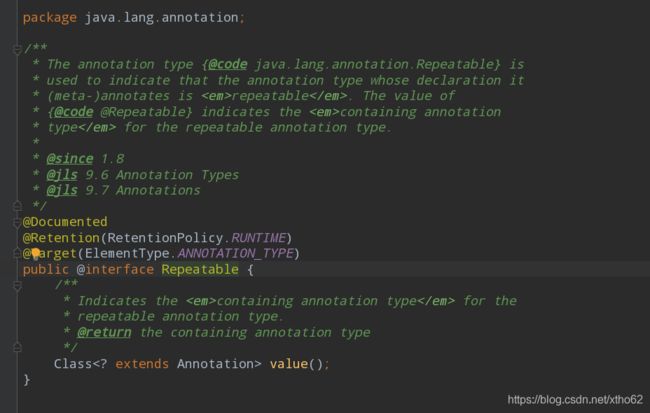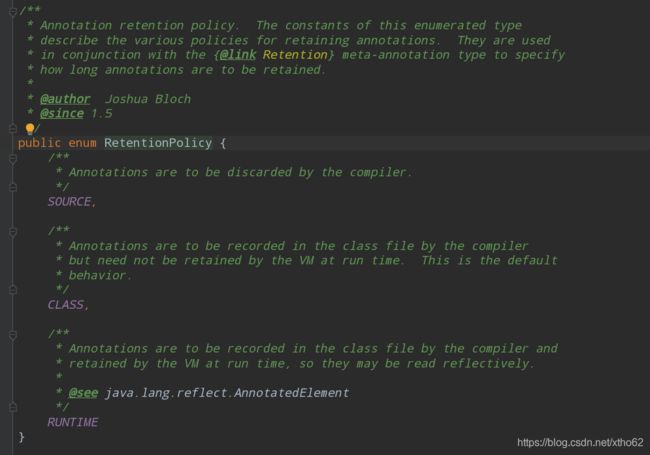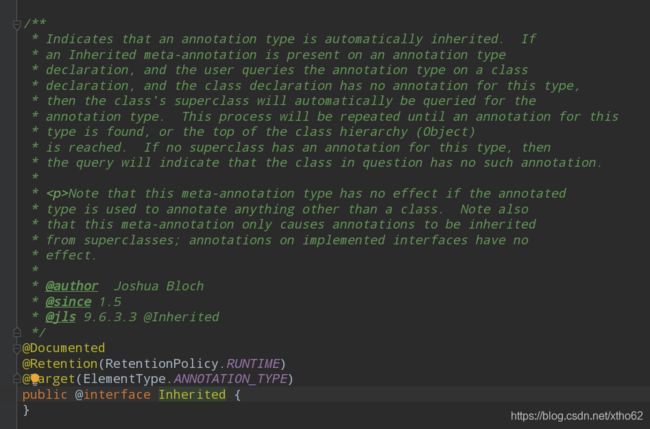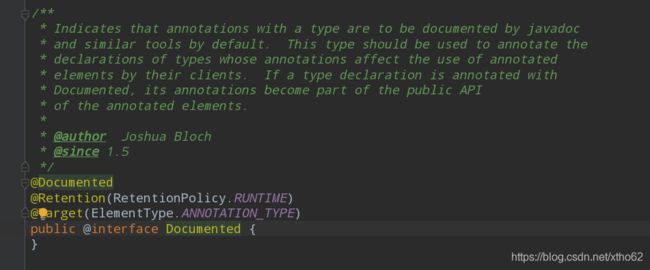Java注解解读-ElementType详解
文章目录
-
- 注解须知前言
- @Target
- @Retention
- @Inherited
- @Documented
- @Repeatable
注解须知前言
Java注解使用是相当频繁,特别是在在框架源码使用,用到类的反射获取方法和属性,用的尤其多,而且即使是编写业务代码时候,也常有使用自定义注解来结合aop来实现减少代码的编写。
接下来我们就来解读一下Java注解。
Java中以前只有4个元注解,Java8后又新增了1个。
在讲解元注解概念之前,我们先建立元数据的概念。 元数据在英语中对应单词 metadata, metadata在wiki中的解释是:
Metadata is data [information] that provides information about other data
为其他数据提供信息的数据
这样元注解就好理解了,元注解 meta annotation用于注解 自定义注解 的注解。
接下来就看看Java中有哪些元注解,如下:
@Target 目标即作用范围
@Retention 保留
@Inherited 遗传,即注解是否可被继承
@Documented 文档,用javadoc命令生成API文档,会又相关信息
@Repeatable (java1.8 新增项)
当没有@Repeatable修饰的时候,注解在同一个位置,只能出现一次
接下来就进行注意讲解:
@Target
/*
* Copyright (c) 2003, 2013, Oracle and/or its affiliates. All rights reserved.
* ORACLE PROPRIETARY/CONFIDENTIAL. Use is subject to license terms.
*/
package java.lang.annotation;
/**
* The constants of this enumerated type provide a simple classification of the
* syntactic locations where annotations may appear in a Java program. These
* constants are used in {@link Target java.lang.annotation.Target}
* meta-annotations to specify where it is legal to write annotations of a
* given type.
*
* The syntactic locations where annotations may appear are split into
* declaration contexts , where annotations apply to declarations, and
* type contexts , where annotations apply to types used in
* declarations and expressions.
*
*
The constants {@link #ANNOTATION_TYPE} , {@link #CONSTRUCTOR} , {@link
* #FIELD} , {@link #LOCAL_VARIABLE} , {@link #METHOD} , {@link #PACKAGE} ,
* {@link #PARAMETER} , {@link #TYPE} , and {@link #TYPE_PARAMETER} correspond
* to the declaration contexts in JLS 9.6.4.1.
*
*
For example, an annotation whose type is meta-annotated with
* {@code @Target(ElementType.FIELD)} may only be written as a modifier for a
* field declaration.
*
*
The constant {@link #TYPE_USE} corresponds to the 15 type contexts in JLS
* 4.11, as well as to two declaration contexts: type declarations (including
* annotation type declarations) and type parameter declarations.
*
*
For example, an annotation whose type is meta-annotated with
* {@code @Target(ElementType.TYPE_USE)} may be written on the type of a field
* (or within the type of the field, if it is a nested, parameterized, or array
* type), and may also appear as a modifier for, say, a class declaration.
*
*
The {@code TYPE_USE} constant includes type declarations and type
* parameter declarations as a convenience for designers of type checkers which
* give semantics to annotation types. For example, if the annotation type
* {@code NonNull} is meta-annotated with
* {@code @Target(ElementType.TYPE_USE)}, then {@code @NonNull}
* {@code class C {...}} could be treated by a type checker as indicating that
* all variables of class {@code C} are non-null, while still allowing
* variables of other classes to be non-null or not non-null based on whether
* {@code @NonNull} appears at the variable's declaration.
*
* @author Joshua Bloch
* @since 1.5
* @jls 9.6.4.1 @Target
* @jls 4.1 The Kinds of Types and Values
*/
public enum ElementType {
/** Class, interface (including annotation type), or enum declaration */
TYPE,
/** Field declaration (includes enum constants) */
FIELD,
/** Method declaration */
METHOD,
/** Formal parameter declaration */
PARAMETER,
/** Constructor declaration */
CONSTRUCTOR,
/** Local variable declaration */
LOCAL_VARIABLE,
/** Annotation type declaration */
ANNOTATION_TYPE,
/** Package declaration */
PACKAGE,
/**
* Type parameter declaration
*
* @since 1.8
*/
TYPE_PARAMETER,
/**
* Use of a type
*
* @since 1.8
*/
TYPE_USE
}
@Target 表示这个注解能放在什么位置上,是只能放在类上?还是即可以放在方法上,又可以放在属性上。从源码中可见,目标注解的值是一个数组,举个例子:
@Target({METHOD,TYPE}),表示他可以用在方法和类型上(类和接口),但是不能放在属性等其他位置。
可以选择的位置列表如下:
值得注意的是,在
Java8中ElementType 新增两个枚举成员,TYPE_PARAMETER和TYPE_USE,在Java8前注解只能标注在一个声明(如字段、类、方法)上,Java8后,新增的TYPE_PARAMETER可以用于标注类型参数,而TYPE_USE则可以用于标注任意类型(不包括class)。如下所示
ElementType.TYPE:能修饰类、接口或枚举类型
ElementType.FIELD:能修饰成员变量
ElementType.METHOD:能修饰方法
ElementType.PARAMETER:能修饰参数
ElementType.CONSTRUCTOR:能修饰构造器
ElementType.LOCAL_VARIABLE:能修饰局部变量
ElementType.ANNOTATION_TYPE:能修饰注解
ElementType.PACKAGE:能修饰包
@Retention
@Retention 表示生命周期
RetentionPolicy.SOURCE: 注解只在源代码中存在,编译成class之后,就没了。@Override 就是这种注解。
RetentionPolicy.CLASS: 注解在java文件编程成.class文件后,依然存在,但是运行起来后就没了。@Retention的默认值,即当没有显式指定@Retention的时候,就会是这种类型。
RetentionPolicy.RUNTIME: 注解在运行起来之后依然存在,程序可以通过反射获取这些信息
@Inherited
指示注释类型是
自动继承的。如果注释类型声明中存在继承的元注释,并且用户在类声明中查询该注释类型,并且该类声明没有该类型的注释,则将自动查询该类的超类以获取注释类型。重复此过程,直到找到该类型的注释,或到达类层次结构(对象)的顶部为止。如果没有超类对此类型进行注释,则查询将指示所讨论的类没有此类注释。请注意,如果带注释的类型用于注释除类之外的任何内容,则此元注释类型无效。还要注意,此元注释仅使注释从超类继承;已实现的接口上的注释无效。
@Inherited 表示该注解具有继承性。
即如果一个使用了@Inherited 修饰的annotation 类型被用于一个class,则这个annotation 将被用于该class 的子类。
@Documented
@Documented 如图所示, 在用javadoc命令生成API文档后,文档里会出现该注解说明
@Repeatable

元注解@Repeatable是JDK1.8新加入的,它表示在同一个位置重复相同的注解。在没有该注解前,一般是无法在同一个类型上使用相同的注解的。
//Java8前无法这样使用
@FilterPath("/update")
@FilterPath("/add")
public class A {}
Java8前如果是想实现类似的功能,我们需要在定义@FilterPath注解时定义一个数组元素接收多个值如下:
@Target(ElementType.TYPE)
@Retention(RetentionPolicy.RUNTIME)
public @interface FilterPath {
String [] value();
}
//使用
@FilterPath({"/update","/add"})
public class A { }
@Target({ElementType.TYPE,ElementType.FIELD,ElementType.METHOD})
@Retention(RetentionPolicy.RUNTIME)
@Repeatable(FilterPaths.class)//参数指明接收的注解class
public @interface FilterPath {
String value();
}
@Target(ElementType.TYPE)
@Retention(RetentionPolicy.RUNTIME)
@interface FilterPaths {
FilterPath[] value();
}
//使用案例
@FilterPath("/update")
@FilterPath("/add")
@FilterPath("/delete")
class AA{ }




